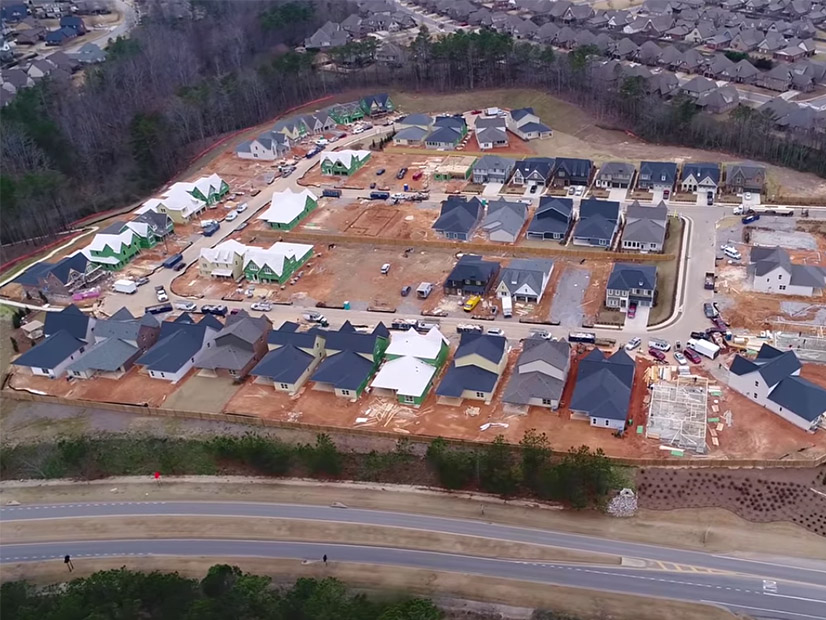
A “connected community” of 62 grid-interactive efficient homes used 44% less energy than a comparable all-electric community, a Department of Energy official said last week during a California Energy Commission workshop.
And the Reynolds Landing pilot project in Hoover, Ala., will soon be followed by other connected community trials. DOE expects to soon announce funding awards to about 10 additional pilot projects, according to David Nemtzow, director of DOE’s Building Technologies Office.
Nemtzow discussed connected communities during an Oct. 5 workshop on grid-interactive efficient buildings, or GEBs. CEC is hosting a series of workshops as part of the process for developing its 2021 Integrated Energy Policy Report.
Grid-interactive efficient buildings incorporate features such as smart thermostats or water heaters that communicate with the electric grid. Some homes might already have those technologies in place.
But GEBs take the technology a step further, by allowing devices to communicate with each other, with the grid, and with distributed energy resources such as solar systems, electric vehicles and energy storage.
The buildings may reduce energy demand through efficient heating and cooling systems or shed load by dimming lights in response to grid signals. They also may be able to export electricity to the grid.
Building Impacts
With nearly 125 million residential and commercial buildings in the U.S., GEBs potentially have a large role to play in meeting climate goals. Buildings account for about 74% of electricity use in the U.S. and 35% of the nation’s energy-related CO2 emissions, Nemtzow said.
“They are where we spend most of our time; they’re where we breathe most of our air; and they’re where we use most of our energy,” CEC Commissioner Andrew McAllister said during the workshop. “So it’s just of fundamental, human importance in uncountable ways that we try to make our built environment as high-performing as it can be.”
Nemtzow said the benefits of GEBs can be even greater if a group of buildings works together as a connected community, sometimes known as a smart neighborhood. A connected community may be able to achieve economies of scale, take advantage of load diversity to smooth out demand curves, add distributed energy resources and encourage new business models.
“We will not do this on a onesie, twosie basis,” Nemtzow said. “We want the whole to be greater than the sum of the parts.”
Pilot Neighborhood
The 62-home Reynolds Landing project was the first DOE-supported connected community. The homes are highly energy efficient and equipped with variable-capacity heat pumps for heating and cooling and hybrid electric/heat pump water heaters. The appliances are internet connected.
The neighborhood’s centralized microgrid includes solar panels, battery storage and a natural gas-fired backup generator. Nemtzow said the 3,000-square-foot, upscale homes sold for about $400,000 each.
The project was a partnership among DOE, Oak Ridge National Laboratory (ORNL), and Alabama Power and its parent company, Southern Co. ORNL software called Complete System Level Efficient and Interoperable Solution for Microgrid Integrated Controls (CSEISMIC) was used in the project.
The software is intended to optimize use of solar, storage and the generator, and can isolate the microgrid during an outage and supply power to the homes.
Two years after Reynolds Landing opened in 2018, the community was using 44% less energy than a comparable all-electric neighborhood. Power demand during winter peak hours was 34% less, ORNL reported.
DOE partnered again with Southern on a smart neighborhood in Atlanta called Altus at the Quarter. The project includes 46 townhouses equipped with rooftop solar, in-home energy storage, and home automation and energy management. Unlike Reynolds Landing, the Atlanta project does not include a microgrid.
Nemtzow said one of the lessons learned from the Reynolds Landing project was that residents would like to know in advance if the system is going to change the temperature of their rooms or hot water. Often the changes aren’t noticeable, but sometimes they are, Nemtzow said.
Residents had the ability to override the system’s algorithm, and some chose to do so, he added.
Commercial, Residential Projects
For the next round of DOE-supported connected communities, Nemtzow said, the projects will be spread out across the U.S.
Although Nemtzow couldn’t reveal the specific projects until DOE makes an official announcement, he said a variety of building types will be represented, including residential, commercial, mixed use, and university or corporate campuses. Some projects will be new construction while others will be building retrofits.
Nemtzow noted that California is known for its leadership on energy issues but said the federal government would like to engage in friendly competition with the state in a “race to the top.”
“I think [it’s] great that we’re doing it together and we’re all moving in the same direction,” California Public Utilities Commissioner Darcie Houck said.
GEB Barriers
DOE has set a goal of tripling energy efficiency and demand flexibility in residential and commercial buildings by 2030, compared to 2020 levels.
The department’s Building Technologies Office released a report in May titled “A National Roadmap for Grid-Interactive Efficient Buildings.” National adoption of GEBs could result in as much as $200 billion in cost savings for the U.S. electric power system over the next 20 years, the report said.
The report also outlines some of the barriers to widespread adoption of GEBs. Better technology is needed to improve interoperability of the systems, address cybersecurity concerns, and provide greater and more consistent load impacts.
In addition, more workforce training is needed related to GEBs, and consumer awareness must be increased.


